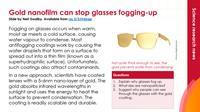Self-warming coating containing a gold nanofilm stops surface fogging and outperforms current antifog technology
-

Download this
Use this story and the accompanying summary slide to add new context when teaching about nanomaterials with your 14–16 learners.
Download the story as MS Word or PDF and the summary slide as MS PowerPoint or PDF.
A gold nanofilm coating for preventing fogging on spectacle lenses, and other transparent surfaces, has been developed by researchers in Switzerland. The coating selectively absorbs the infrared wavelengths of sunlight and converts this energy into heat, which warms the surface to prevent condensation. The coating is both scalable and durable, and has the potential to solve many of the issues with current antifog technologies.
Fogging occurs when warm, moist air encounters a relatively cold surface, causing water vapour to condense. Fogging on the lenses of glasses has always been an issue, especially when wearers come indoors on a cold day. The use of facemasks has made this much more of an issue. Car windows, windshields, mirrors and optical sensors are also susceptible to fogging.
Striking gold
The new coating was developed at ETH Zurich. It contains an approximately 5 nm thick gold layer sandwiched between two layers of titanium oxide. The coating is applied using vapour deposition, a manufacturing method already widely used in industry.
The coating selectively absorbs infrared energy from sunlight. Radiation in the visible range is not absorbed, which explains why the coating is transparent. When the sun is shining on it, the coating heats up the surface by around 8°C. ‘Even at very low sunlight intensity it’s still efficient,’ says Iwan Hächler, one of the researchers involved in developing the coating. ‘The slightest temperature increase has a very strong effect on the likelihood of fog forming,’ he adds.
Iwan and his colleagues tested their coating in a variety of applications, including on the spectacle lenses of an FFP2-mask wearer and on flexible polyester sheets. The coated surfaces performed far better than the uncoated surfaces they were tested against. The researchers have filed a patent application for this technology.
Other approaches

The idea of warming surfaces to stop them fogging isn’t novel. The heated wires in car windows work on the same principle. Passive heating approaches, such as this gold nanofilm coating, are suitable for a wider range of applications because they don’t require an additional energy source.
Photothermal coatings have also been explored before, including for anti-icing surfaces. These have, however, typically absorbed a large part of the visible solar spectrum making them too dark to be used on surfaces that need to be transparent.
Commercial antifogging coatings work either by making the surface superhydrophilic, causing droplets to spread out into thin films, or superhydrophobic, preventing the droplets from sticking at all. Due to performance, durability, and scalability issues, neither approach has reached its full potential.
The use of a gold nanofilm coating for stopping fogging on transparent surfaces ‘is a really interesting, clever idea’, explains Gang Chen, expert in nano engineering at the Massachusetts Institute of Technology, US, who was not involved in this project. ’They’ve seen that this idea could be used for, say, glass, and for that you have to have the film clear in the visible spectral range – and that’s new.’
Put this in context
Find out more about nanotechnology by exploring the role of nanotoxicologist, Vicki, who examines how tiny nanomaterials present in everyday products interact with our bodies.
This article is adapted from Tim Wogan’s in Chemistry World.
Nina Notman
Reference
I Haechler et al, Nat. Nanotechnol., 2022. DOI: 10.1038/s41565-022-01267-1
Download this
Download this article and a one-slide summary with questions to use with your 14–16 students when teaching electrolysis: rsc.li/40GIlRk
Downloads
EiC science research story Gold nanofilm prevents fogging
Handout | PDF, Size 0.2 mbEiC science research story Gold nanofilm prevents fogging
Handout | Word, Size 0.57 mbEiC summary slide Gold nanofilm prevents fogging
Presentation | PDF, Size 0.17 mbEiC summary slide Gold nanofilm prevents fogging
Presentation | PowerPoint, Size 1.41 mb














1 Reader's comment